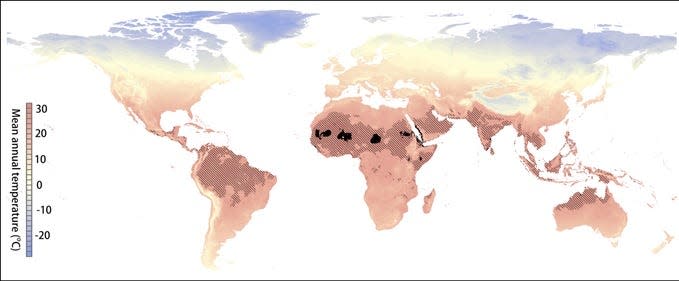Unsuitable for 'human life to flourish': Up to 3B will live in extreme heat by 2070, study warns
If global warming continues unchecked, the heat that's coming later this century in some parts of the world will bring "nearly unlivable" conditions for up to 3 billion people, a study released Monday said.
The authors predict that by 2070, much of the world's population is likely to live in climate conditions that are "warmer than conditions deemed suitable for human life to flourish."
The study warned that unless greenhouse gas emissions are curtailed, average annual temperatures will rise beyond the climate "niche" in which humans have thrived for 6,000 years.
That "niche" is equivalent to average yearly temperatures of roughly 52 to 59 Fahrenheit. The researchers found that people, despite all forms of innovations and migrations, have mostly lived in these climate conditions for several thousand years.
"We show that in a business-as-usual climate change scenario, the geographical position of this temperature niche is projected to shift more over the coming 50 years than it has moved (in the past 6,000 years)," the study warned.
Climate change: 2020 expected to be Earth's warmest year on record, scientists say

The future scenario used in the paper is one in which atmospheric concentrations of greenhouse gases are high. The burning of fossil fuels such as coal, oil and gas releases “greenhouse” gases such as carbon dioxide (CO2) and methane into Earth’s atmosphere and oceans. The emissions have caused the planet’s temperatures to rise to levels that cannot be explained by natural factors, scientists report.
Temperatures over the next few decades are projected to increase rapidly as a result of human greenhouse gas emissions.
Without climate mitigation or migration, by 2070 a substantial part of humanity will be exposed to average annual temperatures warmer than nearly anywhere today, the study said. These brutally hot climate conditions are currently experienced by just 0.8% of the global land surface, mostly in the hottest parts of the Sahara Desert, but by 2070 the conditions could spread to 19% of the Earth’s land area.
This includes large portions of northern Africa, the Middle East, northern South America, South Asia, and parts of Australia.
"Large areas of the planet would heat to barely survivable levels and they wouldn’t cool down again," said study co-author Marten Scheffer of Wageningen University in the Netherlands. "Not only would this have devastating direct effects, it leaves societies less able to cope with future crises like new pandemics. The only thing that can stop this happening is a rapid cut in carbon emissions.”
More: Will an 'unprecedented decline' in carbon emissions help limit climate change?
Arctic warming: Arctic will see ice-free summers by 2050 as globe warms, study says
Rapid reductions in greenhouse gas emissions could halve the number of people exposed to such hot conditions. “The good news is that these impacts can be greatly reduced if humanity succeeds in curbing global warming,” said study co-author Tim Lenton, a climate specialist from the University of Exeter in the United Kingdom.
“Our computations show that each degree warming (Celsius) above present levels corresponds to roughly 1 billion people falling outside of the climate niche," Lenton said. "It is important that we can now express the benefits of curbing greenhouse gas emissions in something more human than just monetary terms.”
The study, which was prepared by an international research team of archaeologists, ecologists and climate scientists, was published Monday in the peer-reviewed journal Proceedings of the National Academy of Sciences.

This article originally appeared on USA TODAY: Climate change: Heat 'nearly unlivable' for up to 3 billion by 2070

